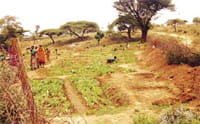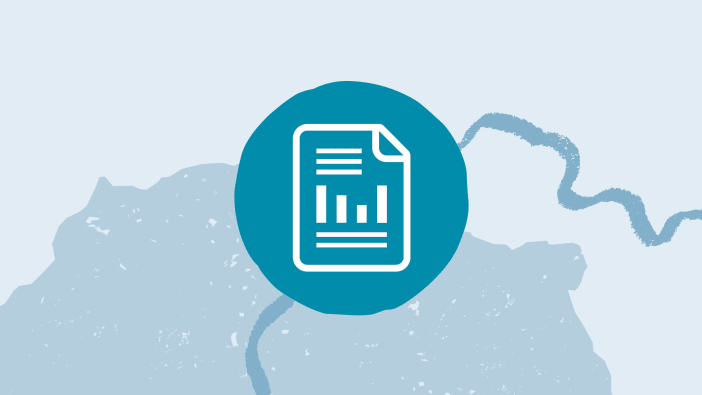People living in dry, infertile areas are often faced with the problem of obtaining fresh vegetables and fruits that are essential for healthy living. At times people might have money to purchase these essential commodities but they might not be available. When they are available they may be in very poor condition after transportation from their producer to reach the consumer.
I recently met an old man who had found a solution to the problem of the lack of fresh vegetables in his town. Wamba is a town in Samburu district in the Rift Valley Province of Kenya. It is located in a dry, semi-arid area, far from the vegetable-producing towns of Kenya. There is sandy soil, high temperatures and little rainfall and the majority of the people are poor and rely on government relief supplies.
The problem
There are very few job opportunities within the town and people rely on food that is brought by traders from towns some 100km away. Fruit and vegetables always reach the residents of Wamba in poor condition, due to exposure to heat and other adverse conditions during transportation. Also, the supply of these commodities is only once a day, meaning that residents have to wait for their arrival in the evening, and there are no supplies over the weekend.
An opportunity
In 2006, a borehole was constructed on the bank of a river that runs near the town. The borehole was meant to provide clean drinking water for the poor residents.
However, Mr Stanley Lekutai, an elderly man in the town, saw another use for the borehole. Mr Stanley was knowledgeable in farming practices and knew how to grow vegetables and take care of crops. He believed he could rely on the borehole and start a vegetable garden to supply vegetables to the local residents. The land in Wamba is mostly communal land and he knew he could acquire a piece without problems. Due to the poor quality and lack of a consistent supply of vegetables to the town, Mr Stanley knew that there was a high demand for fresh vegetables, and since 90% of his village members were jobless he knew he could team up with them and start a garden big enough to supply the town with the required commodity.
Mr Stanley decided to try the idea. He met officials from the organisation that constructed the borehole and shared his idea with them. They agreed to allow him to use the borehole water to grow vegetables. Mr Stanley went to his village and talked to some women about his plans. He outlined his idea to them and promised to teach them how to cultivate the land. He managed to convince 15 women, and together they started the garden.
The method
1 They divided the 100 x 50 metre area into smaller beds and assigned each bed to a specific person. Since Mr Stanley knew that the soil was not very fertile he advised his group members to first scoop up the top-soil and heap it somewhere.
2 They dug out the lower soil to create hollow beds and heaped the dug-out soil on the edge of the garden.
3 Along the lower edge of the garden they dug a trench and heaped the soil along the perimeter of the garden. This trench and heap was to lead run-off rain water away from their garden to prevent flooding.
4 They fenced the garden with thorny acacia twigs and went to collect some top soil from other, more fertile areas. This they mixed with cow manure and spread in the hollow beds.
5 Then Mr Stanley made a nursery bed and planted kale, spinach and cabbages in it. The nearby Catholic Mission and local NGOs helped him to buy the seeds.
The group watered the nursery until the seedlings were ready for transplanting into their garden.
Benefits
The transplanted seedlings grew very well. Mr Stanley and his partners started harvesting the vegetables and supplied them to the other residents of the town at good prices. The residents learned about the garden and today they flock there at noon and in the evening to buy vegetables for their meals.
Mr Stanley and his partners have benefited from their efforts as they now have:
- a source of income
- a job to perform during the day
- fresh vegetables for their families and the community
- a venture which uses their knowledge, skills and energy.
The establishment of the garden has also attracted a number of organisations to their village who have promised to assist Mr Stanley and his group to obtain any help they require, such as buying pesticides and seeds. The local residents have also admired the garden and, together with the schools in the area, have visited it to learn more about the creation and management of the garden. This garden has proved that there can be fresh vegetables in semi-arid areas too.
Loiboku Jeremy
Ereto Group, PO Box 43, 60300, Isiolo, Kenya.
Email: [email protected]
Planting in a sack
A new idea we have learned recently is using a sack to plant vegetables in. I hope this idea will help Footsteps readers around the world. This idea can work in urban, rural and in remote areas as well.
- Take a 100kg sack and an empty four-litre tin. Cut off the top and bottom of the tin to make a tube, and put this at the bottom of the sack.
- Put stones in the tin, and then put good soil around the tin. Then pull up the tin from the soil and put more stones in the tin on this new level, with more good soil around.
- Repeat this process until the sack is full, with a column of stones in the centre and soil around the stones. This is to help the water to spread easily into the soil in the sack.
- Cut holes all around the sack about 10cm apart. Transplant seedlings from a nursery in these holes and on top of the sack, about four inches apart. We have tried kale, onions and tomatoes.
- Add about 20 litres of water every three or four days.
Pastor George Guyo Wako, Africa Inland Church, Titila, c/o Box 21028, 00505, Nairobi, Kenya








